
The following are selected highlights of the 9th Annual iSixSigma Global Salary Survey. The complete report, with more analysis and extended findings (including results for Black Belts (BBs), Master Black Belts (MBBs), Deployment Leaders (DLs), Champions, Quality Professionals (QPs), Quality Executives (QEs) and Business Professionals (BPs); regional highlights; bonuses; how education and experience affect compensation; and much more), is available for purchase on the iSixSigma Marketplace.
How the Survey Is Completed
Data for the Annual iSixSigma Global Salary Survey is collected from the iSixSigma Job Shop, where participants answer several required questions (e.g., location, highest level of education, salary range, etc.). Only information from those who provided or updated their information within the prior 12 months was included in the analysis.
This year’s salary survey includes responses from 1,305 participants.
Please note: Survey participants provide salary information by ranges, beginning at < $20,000, then $20,001 to $25,000, continuing at increments of $5,000 to the final salary range of > $200,000. In analyzing the salary data, each range was converted to the median salary for that specific range. For example, < $20,000 was calculated to be $17,500; $20,001 to $25,000 was calculated to be $22,500; and so on.
If the average salaries of those working in continuous process improvement are any indication, economies are rebounding. According to this year’s Annual iSixSigma Global Salary Survey, most Six Sigma professionals saw an increase in average salary over previous years.
Black Belts
After several years of relatively flat numbers, the average worldwide BB salary rose to $83,107, up 5 percent from the previous year (Figure 1 ). Since the 2004 report, the overall trend has been upward, with BBs experiencing an average increase of 19 percent.
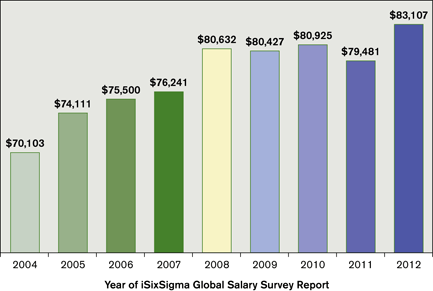
Master Black Belts
MBBs are likewise at a peak salary from the first salary survey report in 2004; MBBs have seen a steady increase in their average salary over that time (Figure 2). The average annual salary of MBBs worldwide is now $117,009.
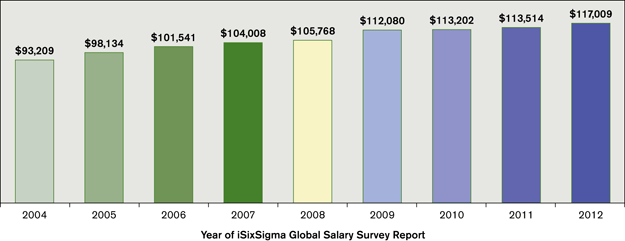
Certification and Roles
Not surprisingly, the overwhelming majority of BBs and MBBs have certifications corresponding to their roles; 93 percent of BBs hold BB certification and 79 percent of MBBs hold MBB certification. The majority of DLs reported that they are certified as MBBs (60 percent) or BBs (36 percent) (Figure 3 ). Certifications remain a strong component for the roles of QE and QP: 97 percent of QEs reported some level of Belt certification, as did 84 percent of QPs (Figures 4 and 5). Close to half of BPs stated that they are certified as BBs (46 percent), with 24 percent certified as MBBs and 13 percent certified as GBs. (Figure 6)
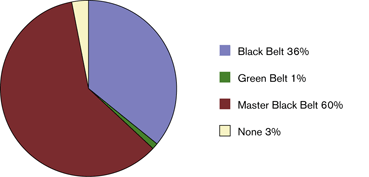
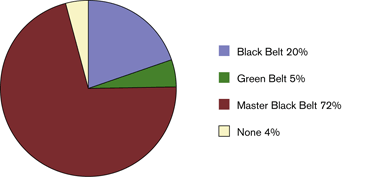
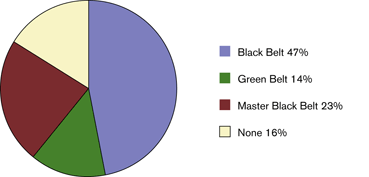
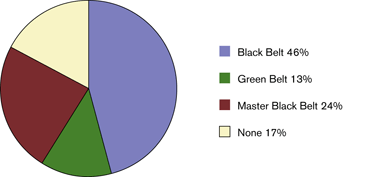
Role Definitions
Black Belt: Full-time professional who leads Six Sigma projects. Typically has four to five weeks of classroom training in methods, statistical tools and team skills. Sometimes provides coaching and Six Sigma expertise to Green Belts.
Master Black Belt: An expert in Six Sigma methodology and statistical tools who provides strategic Six Sigma guidance within a specific function or business unit. An MBB often has prior experience as a BB. Responsible for coaching, mentoring and/or training BBs, an MBB often helps the Six Sigma Deployment Leader and Champions keep the initiative on track.
Champion: Middle- or senior-level executive who sponsors a specific Six Sigma project or effort, ensuring that resources are available and cross-functional issues are resolved.
Deployment Leader: Senior-level executive responsible for implementing Six Sigma enterprise wide. Typically reports to higher C-level executives. Responsible for developing, implementing and maintaining a standardized, company-wide quality system focused on customer satisfaction, defect prevention and continuous improvement.
Quality Professional and Quality Executive: While not universally regarded as Six Sigma roles, QPs and QEs may have Six Sigma responsibilities and qualifications.
Business Professional: Although they may not be in Six Sigma roles currently, the majority of these professionals possess Six Sigma certification and may have project experience. This is the second year BPs are included in iSixSigma’s Global Salary Survey.